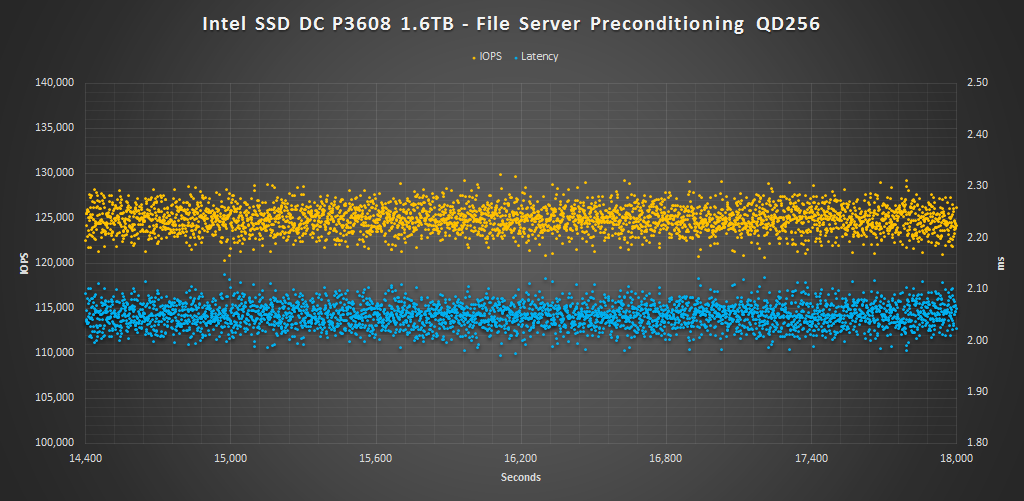SERVER PROFILES CONTINUED
Our last set of profiles include File Server and Web Server workloads. As mentioned before the last hour of preconditioning, the average IOPS, and average latency for each QD is graphed below.
The File Server profile is based on an 80% read/20% write mix. It’s made up of block sizes from 512 to 64K, each making up a different percentage of the access pattern. The pattern is: 512 bytes=10%, 1k=5%, 2k=5%, 4k=60%, 8k=2%, 16k=4%, 32k=4%, 64k=10%.
During the File Server benchmark we can see very similar performance to that of our Email Server results.
The Web Server profile is similar to the File Server profile, but has some additional 128K and 512K accesses thrown in for good measure. Additionally, the profile is 100% reads.
For the Web Server benchmark our preconditioning results are very interesting. IOPS range by about 20K lowest to highest and latency ranges 0.1ms. Performance gradually drops off over 2 minute intervals, but then quickly jumps up. Overall, it reached nearly 250K IOPS in RAID 0 at QD256 and latency is well controlled reaching the highest average of 1.03ms.
 The SSD Review The Worlds Dedicated SSD Education and Review Resource |
The SSD Review The Worlds Dedicated SSD Education and Review Resource | 


Random adjectives, desperate efforts to “humanize” the tech resulted in this huge review to contain next to no information at all.
There is no easy way to say this: software RAID 0 on PCIe is simply retarded.
Thanks for your thoughts
Now just make it affordable
Well, for enterprise it is very affordable for what you get. If you are concerned about consumers/enthusiasts I can see where you are coming from, but this is not meant for them. Next year, however, we may be seeing performance like this trickle down.
More than likely next year
As an enterprise product I can see it as a high-end workstation device but not a server device. The lack of RAIDability seems to limit its use to caching and high-speed scratch work area.
I’ve been informed that PCIe hardware RAID will be available on the Skylake CPU and the Xeon version when it comes out later. Now we’re talking………
so this is a preview, not a review… where are the comparisons to P3700 and PM951?
I don’t have access to those drives. We reviewed the P3700 in another system. Because of that as well as a change in our testing methodology, we cant not graph them side by side. Looking at the P3700’s specific review you can gauge for yourself the approximate performance difference between the two.